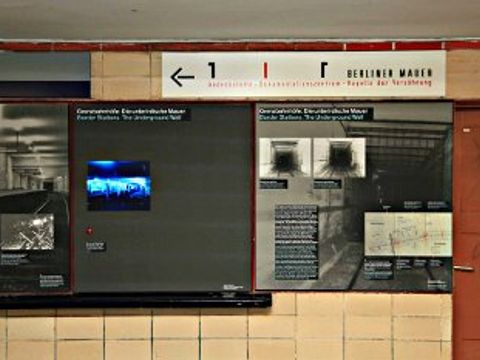The exhibition at Nordbahnhof highlights the absurdity of the division, as demonstrated by the three U-Bahn and S-Bahn lines that ran under East Berlin to take passengers from one West Berlin station to another and, from 1961 to 1989, occupied a special position in the city’s otherwise divided public transportation network. The trains used on these lines (today’s U6 and U8 and the north-south S-Bahn line) no longer stopped at the deserted stations in East Berlin and could not be boarded there. Although passengers from West Berlin were used to the situation, passing through these stations under East Berlin was still a strange experience, which is why West Berliners referred to them as “ghost stations.” The trains traveled through them slowly without stopping, and armed guards could be seen on dimly lit platforms. Before the trains entered East Berlin, a warning would come over the U-Bahn loudspeaker: “Last stop in West Berlin!”
Visitors’ information:
- Nordbahnhof S-Bahn station; entrance on Gartenstrasse; on the mezzanine
- Admission free
- Open during the station’s hours of operation
The exhibition presents five different perspectives on this theme:
- When the GDR leadership put up a wall to divide the city in 1961, it severed previously intact parts of Berlin’s public transportation network (U-Bahn and S-Bahn lines). The “ghost lines” were a peculiar side effect of the division.
- The term “ghost station” reflects the perspective of passengers from West Berlin passing through deserted stations guarded by soldiers or police. The memories of West Berliners are dominated by the image of armed guards standing on the platforms, the uncanny atmosphere of the empty stations, and the feeling of uncertainty associated with being on foreign territory underground.
- The perceptions of West Berliners are contrasted with the perspective of East Berliners, who could no longer use these lines. The station entrances in East Berlin were boarded up and sometimes erased from the cityscape entirely. Little by little, the stations also disappeared from maps of the city. The longer the division lasted, the more the lines used before 1961 sank into oblivion.
- At the same time, the U-Bahn and S-Bahn tunnels seemed to offer a possible escape route into West Berlin. Lots of people tried to find a way into the bricked-up, barricaded stations in the hope of being able to reach the West through the underground tunnels. Most of these escape attempts failed, landing the would-be fugitive in a GDR prison. The exhibition shows both successful and unsuccessful attempts and also touches on the relatively high number of border guards who tried to flee the country.
- The perspective of East Berliners is contrasted with that of the GDR government, which did everything it could to prevent the underground transport system from being used for an escape. The SED leadership built up a complex system of walls, barriers, and signaling installations aimed at thwarting every attempt.
The exhibition “Border stations and ‘ghost stations’ in divided Berlin,” which was the first element of the Berlin Wall Memorial’s outdoor exhibition on Bernauer Strasse to be completed, includes photos and stories that were previously unknown and reminds its visitors of individual fates that had been forgotten. A Berlin Wall History Mile info board in front of the station publicizes the exhibition inside.

